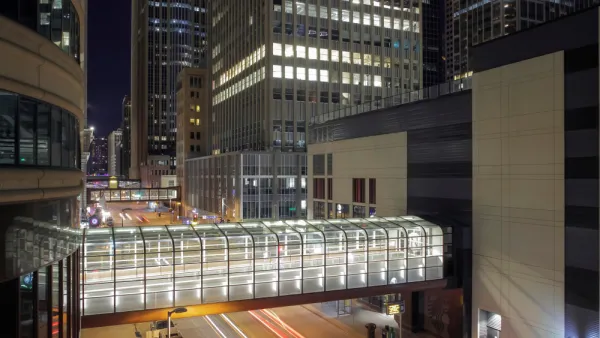Bill Lindeke discusses the history of Minneapolis' Skyways and argues why we shouldn't celebrate a system that he believes is failing its downtown.
August 26th marked the 50th anniversary of the Minneapolis Skyway System, and Lindeke gives readers a history lesson of the skyway design, going all the way back to the 1880's and the first elevated sidewalks and pedestrian bridges.
Lindeke traces Minneapolis's system to the genesis of the city's planning department in the late 1950s, and their vision for "preserviong the future of downtown." In a 1959 plan, "second-level walks" are introduced as a means to improve transportation and reduce congestion. According to Lindeke, "the 1959 plan is sanguine about skyways. Not only would they move faster, they'd lead healthier lives. As the plan states, 'persons in the central area will gain a more relaxed attitude which will presumably add to their efficiency and improve their general well-being and attitude toward life. Since there are so many of them, this could have a salutary effect on the whole city.' Second-level walks were the urban equivalent of Prozac."
These skyways have since become a staple design in the city, from the initial span crossing Marquette Avenue in 1962, through the 80's building boom and into present day. But Lindeke offers sharp criticism, begging the question of whether skyways are "one of the main things casting a dark shadow on a potential downtown renaissance."
Lindeke touts his belief that although the design was intended to improve the downtown core, it's actually hurting itself. "The density and diversity of a downtown sidewalk is pretty much what defines a city, and Minneapolis is missing out."
FULL STORY: Happy 50th Birthday to the Minneapolis Skyway System!

National Parks Layoffs Will Cause Communities to Lose Billions
Thousands of essential park workers were laid off this week, just before the busy spring break season.

Retro-silient?: America’s First “Eco-burb,” The Woodlands Turns 50
A master-planned community north of Houston offers lessons on green infrastructure and resilient design, but falls short of its founder’s lofty affordability and walkability goals.

Delivering for America Plan Will Downgrade Mail Service in at Least 49.5 Percent of Zip Codes
Republican and Democrat lawmakers criticize the plan for its disproportionate negative impact on rural communities.

Test News Post 1
This is a summary

Test News Headline 46
Test for the image on the front page.

Balancing Bombs and Butterflies: How the National Guard Protects a Rare Species
The National Guard at Fort Indiantown Gap uses GIS technology and land management strategies to balance military training with conservation efforts, ensuring the survival of the rare eastern regal fritillary butterfly.
Urban Design for Planners 1: Software Tools
This six-course series explores essential urban design concepts using open source software and equips planners with the tools they need to participate fully in the urban design process.
Planning for Universal Design
Learn the tools for implementing Universal Design in planning regulations.
EMC Planning Group, Inc.
Planetizen
Planetizen
Mpact (formerly Rail~Volution)
Great Falls Development Authority, Inc.
HUDs Office of Policy Development and Research
NYU Wagner Graduate School of Public Service



























